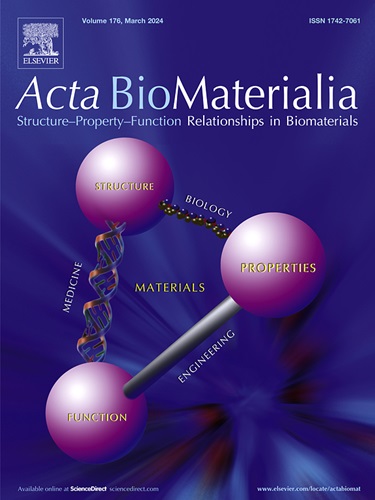Mechanical properties of fresh rhesus monkey brain tissue
IF 9.4
1区 医学
Q1 ENGINEERING, BIOMEDICAL
引用次数: 0
Abstract
Studying brain tissue mechanics is critical for understanding how the brain's physical properties influence its biological functions. Non-human primates, such as rhesus monkeys, are a key translational model for human neuroscience research, yet their brain tissue mechanics remain poorly understood. We report the mechanical properties of rhesus monkey white (corona radiata, CR) and gray (basal ganglia, BG) matter during compression relaxation, tension relaxation, tension-compression cycling (strain = 0.15, nCR = 21, nBG = 14), and shear cycling (strain = 0.3, nCR = 17, nBG = 9). Compression relaxation yields short and long-term time constants of 1.13 ± 0.041 s and 26.3 ± 0.68 s for CR and 1.22 ± 0.046 s and 28.3 ± 0.70 s for BG. Tension relaxation yields short and long-term time constants of 1.10 ± 0.052 s and 28.2 ± 0.82 s for CR and 1.19 ± 0.052 s and 29 ± 1.3 s for BG. Tension-compression cycling yields elastic moduli (E₁, E₂, E₃) of 36 ± 3.8 kPa, 0.61 ± 0.096 kPa, and 9.3 ± 0.90 kPa for CR and 27 ± 4.8 kPa, 0.68 ± 0.092 kPa, and 8 ± 1.0 kPa for BG. Shear cycling yields E₁, E₂, and E₃ of 3.9 ± 0.77 kPa, 0.19 ± 0.034 kPa, and 3.1 ± 0.40 kPa for CR and 2.8 ± 0.52 kPa, 0.18 ± 0.058 kPa, and 3.2 ± 0.53 kPa for BG. Hysteresis areas are also captured during tension-compression and shear cycling. These findings extend the translatability of rhesus monkey models for neuroscience.
Statement of Significance
While rhesus monkeys are a valuable translational model in human neuroscience research, there is a huge gap in knowledge about rhesus monkey brain tissue mechanics. This study serves to increase our understanding of rhesus monkey brain tissue mechanics and is the first to report the stiffness, time constant, and hysteresis parameters for rhesus monkey brain tissue in compression, tension, and shear for both the corona radiata and basal ganglia. The data is available in an open-source format, allowing others to fit and validate their mechanical models.

新鲜恒河猴脑组织的力学特性。
研究脑组织力学对于理解大脑的物理特性如何影响其生物功能至关重要。非人类灵长类动物,如恒河猴,是人类神经科学研究的关键转化模型,但它们的脑组织力学仍然知之甚少。我们报告的机械性能猕猴白色(放射冠,CR)和灰色(基底神经节,BG)压缩期间放松,紧张放松,方法循环(应变 = 0.15,nCR = 21日nBG = 14),和剪切循环(应变 = 0.3,nCR = 17日nBG = 9)。压缩松弛得到CR的短期和长期时间常数分别为1.13±0.041 s和26.3±0.68 s, BG的短期和长期时间常数分别为1.22±0.046 s和28.3±0.70 s。张力松弛的短期和长期时间常数CR分别为1.10±0.052 s和28.2±0.82 s, BG分别为1.19±0.052 s和29±1.3 s。张压循环产生的弹性模量(E₁、E₂、E₃)CR为36±3.8 kPa、0.61±0.096 kPa、9.3±0.90 kPa, BG为27±4.8 kPa、0.68±0.092 kPa、8±1.0 kPa。剪切循环产生的E₁、E₂、E₃的强度CR分别为3.9±0.77 kPa、0.19±0.034 kPa、3.1±0.40 kPa, BG分别为2.8±0.52 kPa、0.18±0.058 kPa、3.2±0.53 kPa。在拉压缩和剪切循环过程中也捕获了滞后区域。这些发现扩展了神经科学中恒河猴模型的可翻译性。意义声明:虽然恒河猴是人类神经科学研究中有价值的转化模型,但关于恒河猴脑组织力学的知识仍存在巨大差距。本研究增加了我们对恒河猴脑组织力学的认识,并首次报道了恒河猴脑组织辐射冠和基底节区在压缩、拉伸和剪切时的刚度、时间常数和迟滞参数。数据以开源格式提供,允许其他人拟合和验证他们的力学模型。
本文章由计算机程序翻译,如有差异,请以英文原文为准。
求助全文
约1分钟内获得全文
求助全文
来源期刊

Acta Biomaterialia
工程技术-材料科学:生物材料
CiteScore
16.80
自引率
3.10%
发文量
776
审稿时长
30 days
期刊介绍:
Acta Biomaterialia is a monthly peer-reviewed scientific journal published by Elsevier. The journal was established in January 2005. The editor-in-chief is W.R. Wagner (University of Pittsburgh). The journal covers research in biomaterials science, including the interrelationship of biomaterial structure and function from macroscale to nanoscale. Topical coverage includes biomedical and biocompatible materials.
 求助内容:
求助内容: 应助结果提醒方式:
应助结果提醒方式:


